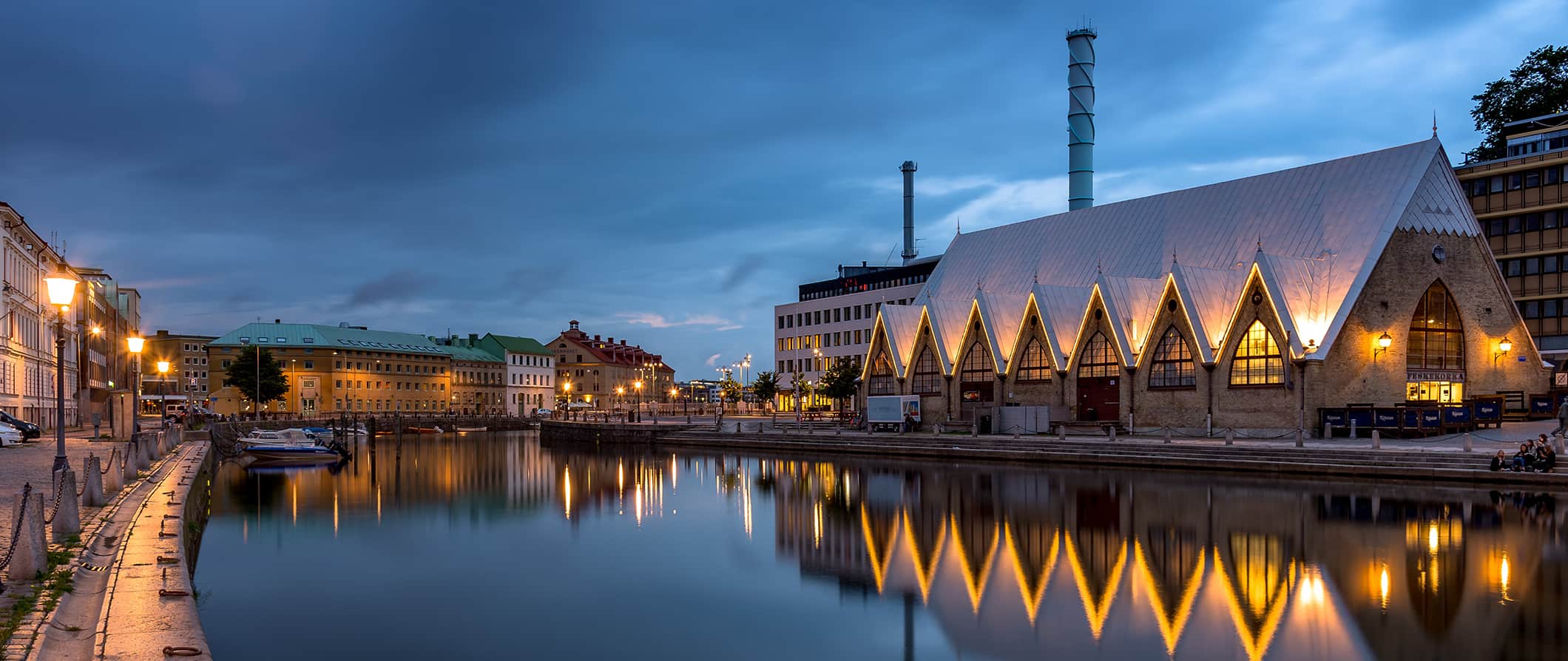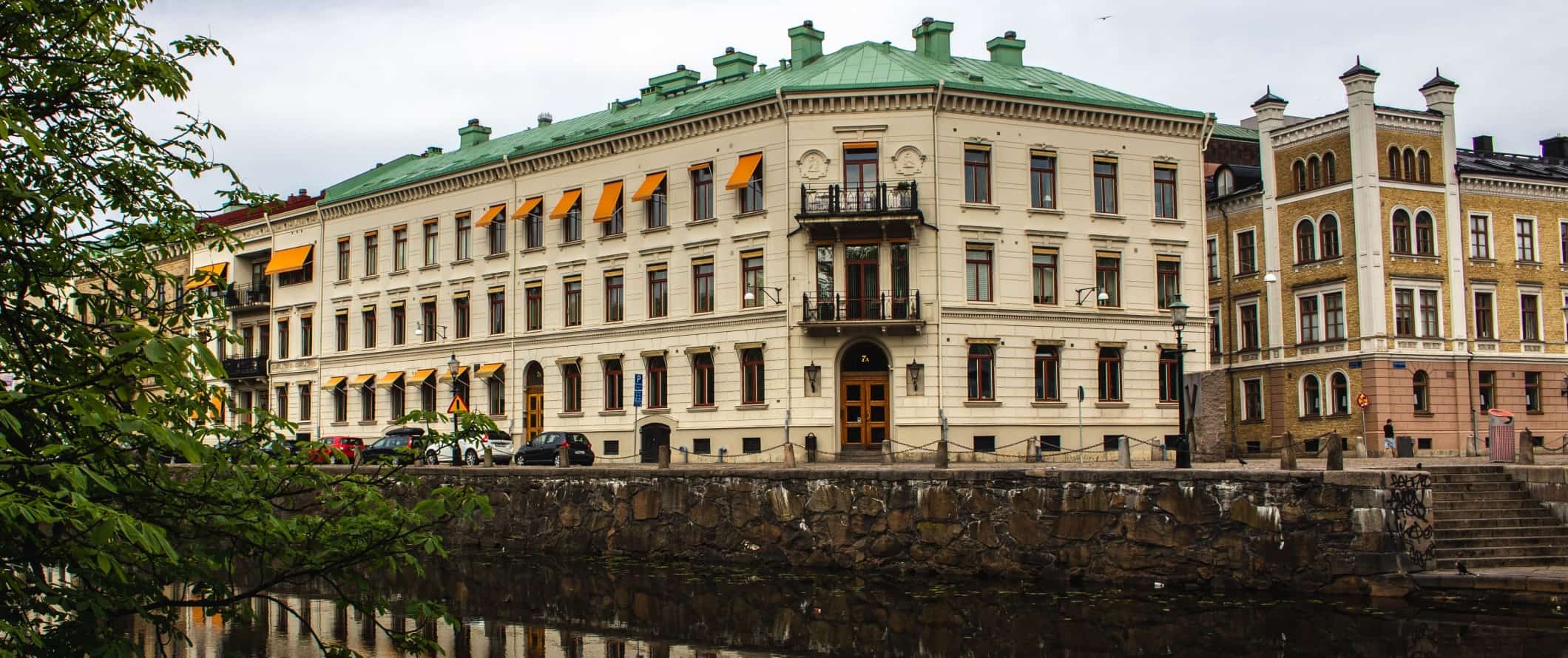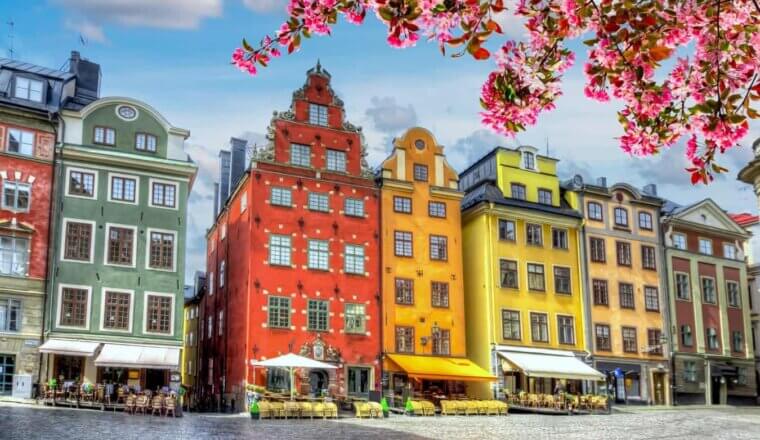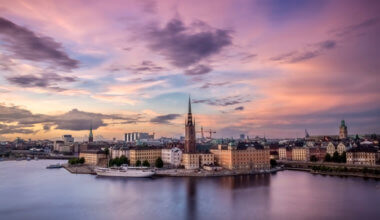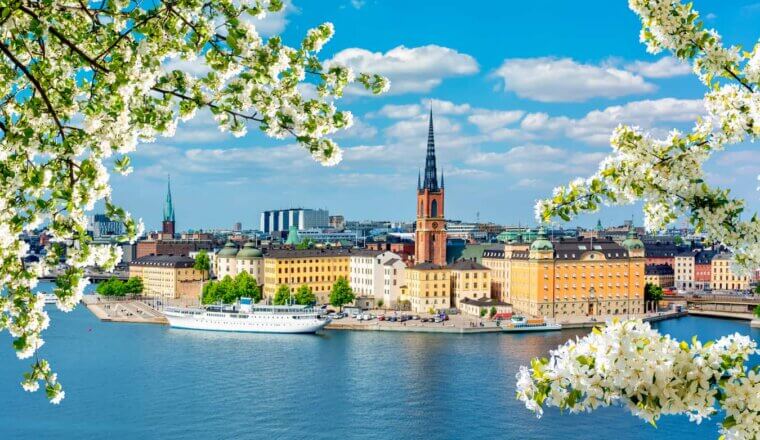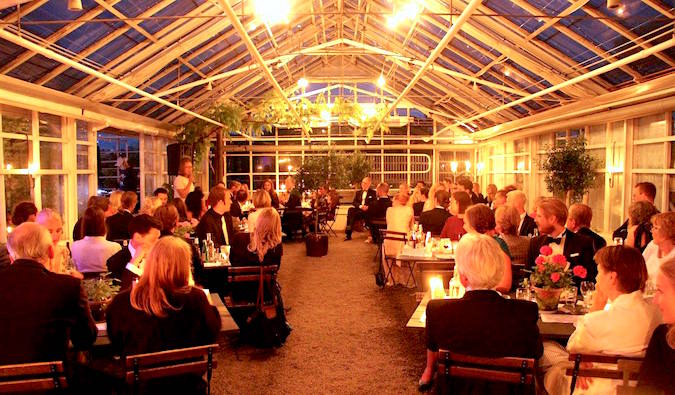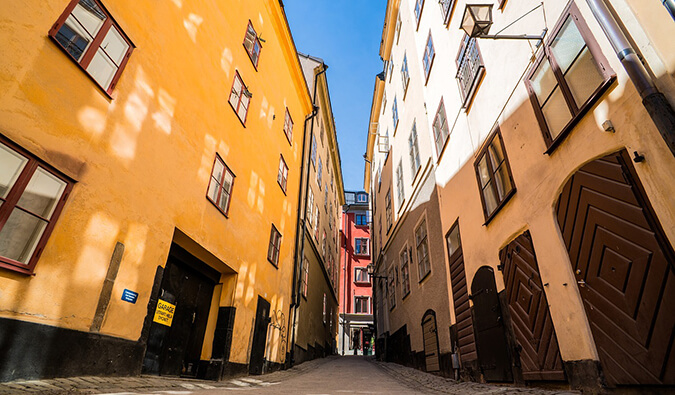As the second-largest city in Sweden, Gothenburg (Göteborg in Swedish) has a lot to offer travelers. Not a lot of people visit Gothenburg in comparison to other parts of the country (like Stockholm), but I really enjoyed my time here.
The city was founded as a Dutch trading colony in 1621 due to its strategic location on the coast. Today, the city remains an important industrial city, as the Port of Gothenburg is the largest port in the Nordic countries.
Despite its industrial background, the city is much more relaxed than Stockholm. With plenty of green space both in and around the city, Gothenburg manages to maintain a small city feel while offering plenty of things to see and do. And with a compact downtown, Gothenburg is easy to explore on foot or by bicycle. The many students (thanks to the several large universities) lend a vibrant, youthful feel to the city.
This travel guide to Gothenburg can help you plan your trip, save money, and help you make the most of your time in Sweden’s second city!
Table of Contents
Top 5 Things to See and Do in Gothenburg
1. Have fun at Liseberg
This is the biggest amusement park in Scandinavia, with rollercoasters, a haunted house, tons of rides for kids, and a giant Ferris wheel with stunning views of the city. Admission is 95 SEK while admission and unlimited rides are 255 SEK.
2. Explore the Haga
As one of the oldest areas of Gothenburg, this was once a working-class neighborhood. It’s now a popular summer destination lined with upscale antique shops and cozy cafes. It’s a great place to stroll and relax. Head to Café Husaren for huge cinnamon buns.
3. Visit the Gothenburg Botanical Garden
This botanical garden is one of the largest in all of Europe. Spanning 430 acres, the garden is home to over 16,000 plant species, a Japanese garden, and places to sit down and relax with a good book. There is a voluntary entrance fee of 20 SEK.
4. Visit the Skansen Kronan
This redoubt (fort) was built in the 1600s outside of the city walls. Armed with 23 cannons, it was built to prevent a potential Danish attack on the city and was later converted into a prison and then a museum. It makes for an interesting excursion and offers insights into Gothenburg’s history.
5. Take a day trip to Marstrand
An hour bus ride from the city is the charming island of Marstrand. In the summer, this island is bustling with visitors who tour the narrow streets and visit the stone fortress, Carlsten (a definite must!). From here, it’s just a stone’s throw to the smaller, more secluded islands of Dyrön and Åstol.
Other Things to See and Do in Gothenburg
1. Go shopping on the “Avenyn”
Kungsportsavenyen (colloquially known as the Avenyn, which is pronounced like “avenue”) is the city’s main shopping street. Stores and restaurants of all price ranges are here. It’s a good place to eat, people-watch, shop, and soak up the heart of the city.
2. See Slottsskogen
Take a stroll through the wooded hills, where you can visit a zoo and a family-friendly animal park. The area is also home to the city’s oldest observatory and there are lots of jogging trails too. In the summer, there is a cafe in the park where you can stop for a snack. This is one of the best places in the city to have a picnic as well. Best of all? It’s free!
3. Visit the Natural History Museum
Located right next to Slottsskogen, this museum is full of all sorts of animals, including the world’s only mounted blue whale. Here you’ll find African elephants, dinosaur fossils, and tons of other mounted animal displays. It’s a good educational activity for kids. Admission is free.
4. Take in the Gothenburg Opera
Built in 1994, the gorgeous Opera House is an important monument of the city. It has over 1,300 seats and, although some tickets are pricey, you can find last-minute ticket deals at the box office. There are often musical productions performed in English as well. Tickets usually range between 100-950 SEK per person.
5. Picnic in Trädgårdsföreningen
This 19th park and garden sits in the heart of the city and is a fantastic place to relax and have a picnic. There is a playground for children, numerous greenhouses full of interesting flora (which you can visit for free), sculptures, gardens, and plenty of shade if you want to sit down with a good book.
6. Climb aboard the Swedish Ship Götheborg
This is a reconstruction of a mid-18th-century ship from the Swedish East India Company. The original ship sank off the coast in 1745 after returning from China. Built from 1995-2003, this reconstruction is one of the world’s largest operational wooden ships. It often tours different ports around the world so make sure it’s in Gothenburg before trying to visit. The ship is open to the public on weekends only and tickets are 150 SEK.
7. Learn some local history
The City Museum in Gothenburg offers some great exhibits, with detailed information about city development and artifacts like old local clothing and household goods. The highlight is undoubtedly the detailed exhibit on the Vikings. This is a super interesting place to visit when you first arrive to get a solid understanding of the city and its past. Adult admission is 60 SEK, while students and visitors under 20 enter free.
8. Spend time at the Gothenburg Museum of Art
If you’re an art lover, take advantage of the sparse crowds at this art local museum. The museum’s collection features both Swedish and international work dating from the 17th century onward. It includes art from big names like Rembrandt, Picasso, and Monet. Admission is 60 SEK though it’s free for students and anyone under 20.
9. Tour the Volvo Museum
If planes, trains, and automobiles are more your thing, head to the Volvo Museum. Founded in 1927, Gothenburg serves as the company’s headquarters and the museum gives an outline of Volvo’s history as well as the evolution of their vehicle designs over the past few decades (it was Volvo that invented the three-point seatbelt we all use today). Admission is 120 SEK.
10. Wander through Delsjön
Just outside of the city lies Delsjön, a nature area with lakes and wooded trails. The park spans almost 500 acres. You can run, go for a hike, or rent canoes here in the summer. I love the peace and quiet of the park. It’s easy to get to via the public tram too.
12. Explore Universeum
If you’re traveling with kids (or just want to act like a kid) head to Universeum. It’s an interactive science center that opened in 2011, offering an indoor rainforest, a chemistry lab, dinosaur exhibits, and much more. It’s a great way to have fun and learn a thing or two along the way. Admission is 225 SEK for adults and 175 SEK for kids under 16.
For more information on other cities in Sweden, check out these guides:
Gothenburg Travel Costs
Hostel prices – Hostels start around 250 SEK per night for a dorm room with 8-10 beds and 725 SEK for a private room. Some hostels charge an additional fee (usually around 50-80 SEK) for bed linens in dorm rooms (you can bring your own, however sleeping bags are not permitted). Free Wi-Fi is standard and most hostels also have self-catering facilities.
Wild camping is legal in Sweden so thought traveling with a tent can camp outside the city with ease thanks to the country’s generous Freedom to Roam laws. Just make sure you’re not camping near someone’s house.
Budget hotel prices – Budget hotels cost around 700 SEK per night. Cheaper options are available, however, they usually require sharing a bathroom with other guests. Many hotels have a sauna on site. Expect basic amenities like free Wi-Fi, TV, and coffee/tea makers.
Food prices – Food in Sweden is hearty and based heavily on meat, fish, and root vegetables. One of the most iconic and popular dishes is meatballs and a creamy sauce with potatoes and lingonberry jam. Crayfish, shrimp, mushrooms, and fresh summer berries are other popular staples. For breakfast, Swedes usually eat dark bread with cheese and vegetables. For fika, cinnamon buns are the go-to choice for many.
Food is expensive in Gothenburg (as it is everywhere in Sweden). Cheap food from outdoor street vendors starts at 50 SEK, though these vendors are few and far between.
Most convenience stores and cafes offer pre-packaged sandwiches and meals for 50-100 SEK if you want a quick bite. Hot dogs cost around 30 SEK at places like 7-Eleven and Pressbyran. A fast-food combo meal is around 90 SEK.
At fast-casual style eateries, whole pizzas cost around 65-95 SEK while a burger is 75-90 SEK. Most nice sit-down restaurant meals are around 190-275 SEK for a main dish. A three-course dinner at a fine dining restaurant is around 450 SEK.
If you’re looking for a drink, beer can be as cheap as 40 SEK, though 65-75 SEK is more common. Wine costs around 55-75 SEK at your average restaurant, and cocktails are around 100 SEK.
All the best bars and pubs are be found near Järntorget and Andra långgatan (the more touristy and expensive places are on “the Avenyn”).
For a filling buffet, head to Café Andrum. For a quick bite on the go, Jonsborg has burgers and hotdogs (as well as vegan options).
Grocery shopping costs around 600-700 SEK per week for basic staples like pasta, rice, and veggies. If you cut down on your meat and cheese intake (some of the most expensive food items in Sweden) you can lower your costs significantly. Willy’s is the cheapest of the large supermarket chains.
Backpacking Gothenburg Suggested Budgets
On a backpacking budget, you should plan to spend around 680 SEK per day. This is a suggested budget assuming you’re staying in a hostel dorm, cooking all your meals, using public transportation to get around, limiting your drinking, and participating in cheap activities like visiting free museums and hanging out in the parks.
On a mid-range budget of 1,280 SEK per day, you can stay in a private room in a hostel, get a public transportation card and take an Uber or two, eat most meals out at fast food joints, enjoy a couple drinks, and visit more paid attractions (like Liseberg or Universeum).
On a “luxury” budget of 2,075 SEK or more per day, you can stay in a budget hotel, drink more, eat out for all your meals, take taxis everywhere, and do whatever tours and activities you want. This is just the ground floor for luxury though. The sky is the limit!
You can use the chart below to get an idea of how much you need to budget daily. Keep in mind these are daily averages – some days you’ll spend more, some days you’ll spend less (you might spend less every day). We just want to give you a general idea of how to make your budget. Prices are in SEK.
Gothenburg Travel Guide: Money-Saving Tips
While Gothenburg is cheaper than Stockholm, it’s still a far cry from a budget-friendly destination. Fortunately, there are ways to slash your spending here. Here are some of my ways to save money in Gothenburg during your visit:
- Stay with locals for free – Accommodation is expensive in Gothenburg. Consider using Couchsurfing to stay with a local. It’s a great way to get to know the local culture because you’re staying in someone’s home and you can ask them all the questions you want.
- Avoid eating in the tourist district – While Haga and the Avenyn are great places to stroll and soak in the city, they are also the most crowded, most expensive places to grab a bite to eat. Wander around some of the smaller streets to find cheaper options.
- Free walking tours – Göteborg Walking Tours runs the best walking tours in the city. They offer a few different walks depending on what you’re interested in (they even have a fika tour). They generally last two hours and are available in English. Just be sure to tip your guide at the end!
- Drink beer – If you are going to drink, stick to beer. It costs about half as much money as mixed drinks or wine at the bars and restaurants. For greater savings, buy your own alcohol at the government-run Systembolaget (it can be up to 50% cheaper that way).
- Try the lunch buffets – If you choose to eat out, the lunch buffets are an economical way to do so, costing around 105 SEK. They are a popular option with locals. For cheap hot dogs and burgers (including vegan options) head to Jonsborg.
- Refill your water bottle – Water is about 30 SEK per bottle. Since the tap water is drinkable (it’s one of the cleanest in Europe!) you should just bring a reuseable water bottle. Not only does this save you money, but it saves the environment too! LifeStraw is my go-to brand since their bottles have built-in filters to ensure your water is clean and safe.
- Avoid the taxis – With the buses running late, you should be able to skip the cabs (the city is very walkable too). A typical ride costs more than 200 SEK, so unless you are far from the bus and it’s snowing out, the price is hard to justify.
- Save money on rideshares – Uber is cheaper than taxis and is the best way to get around a city if you don’t want to wait for a bus. That said, the buses go everywhere and the city is walkable so you shouldn’t need one.
Where to Stay in Gothenburg
Gothenburg has a few hostel accommodations, though they aren’t quite as nice as the ones in Stockholm. These are my suggested and recommended places to stay in Gothenburg:
How to Get Around Gothenburg
Public transportation – The public transportation within Gothenburg costs 34 SEK per ticket. Tickets last 90 minutes and can be transferred from buses to trams and ferries. A day pass costs 110 SEK while a 3-day pass costs 210 SEK. These also work for buses, trams, and ferries.
When coming from Landvetter airport, the bus is your cheapest option. Flygbussarna runs shuttles regularly, with tickets costing 119 SEK (one way) when bought in advance. The journey takes around 30 minutes. Flixbus also runs airport shuttles but they come less frequently (however, they are cheaper at around 99 SEK when purchased in advance).
Taxi – Taxis here are quite expensive. Fares start at 51 SEK and go up by 14 SEK per kilometer, which means an average ride is likely going to cost you over 200 SEK!
Bicycle – You can rent bikes all around the city using Styr & Ställ. A 20 minute ride costs 30 SEK. The cheaper option is to get a one-month Styr & Ställ card for 90 SEK and then you’ll have free 60-minute access to rentals all around the city.
Ridesharing – Uber here is a little cheaper than taxis but it’s still quite expensive. I don’t recommend using it unless you have to.
Car rental – Car rentals are expensive at 430 SEK per day. They’re unnecessary in the city, so I would only recommend getting one if you want to explore the surrounding region (and even then, a car isn’t super necessary since the buses and trains go everywhere).
When to Go to Gothenburg
The ideal time to visit Sweden is from June to August, when the weather is warm and the days are (really) long. Gothenburg is at its liveliest during this time, with locals taking advantage of the good weather at every opportunity. The parks are always full, and there are tons of fun events happening around town. Temperatures are often in the 20s Celsius (60s and 70s Fahrenheit) during the summer months.
The downside to visiting then is that, since Sweden has a very short summer, the city is rather crowded, so be sure to book your accommodation in advance. This is especially true if you are visiting during Midsommar, the big Swedish holiday at the end of June. It’s a great time to experience Swedish traditions (which involve a lot of drinking)!
May typically has great weather with occasional rain, while September offers cooler temperatures and changing leaves. You’ll beat the crowds and still be able to explore the city on foot without the weather getting in your way (too much).
Attractions begin to close around late September, and the days get dark early in October. Temperatures start dropping around this time too. However, prices also decrease, and you’re likely to find cheaper airfares and accommodations during this time. Be sure to pack layers if you plan on visiting during this time of year.
The winter is very cold and sees a lot of snow and darkness. In the depths of the winter, you only get a few hours of light each day and temperatures plummet below -0ºC (32ºF). The plus side of traveling during the off-season, however, is that it’s when accommodations are the cheapest, and fees for certain attractions are lower as well.
While Gothenburg is quite beautiful in winter, you won’t want to be walking around as much, and since it’s a great city to explore on foot, you will potentially be missing out so I’d skip a winter visit if you can.
How to Stay Safe in Gothenburg
Sweden is one of the safest countries in the world. Crime here is rare and solo travelers — including solo female travelers — should feel safe. That said, Gothenburg is still a large city so keep an eye out for pickpockets, especially around the central station and on public transportation.
As in any city, always keep an eye on your drink when out at the bar and never walk home alone if you’re intoxicated.
In general, long as you are aware of your surroundings and use common sense and you should be just fine.
If you do experience an emergency, dial 112 for assistance.
If you’re worried about getting ripped off, here’s a list of common travel scams to avoid.
Always trust your gut instinct. Make copies of your personal documents, including your passport and ID. Forward your itinerary along to loved ones so they’ll know where you are.
The most important piece of advice I can offer is to purchase good travel insurance. Travel insurance will protect you against illness, injury, theft, and cancellations. It’s comprehensive protection in case anything goes wrong. I never go on a trip without it as I’ve had to use it many times in the past.
Gothenburg Travel Guide: The Best Booking Resources
These are my favorite companies to use when I travel. They consistently have the best deals, offer world-class customer service and great value, and overall, are better than their competitors. They are the companies I use the most and are always the starting point in my search for travel deals.
- Skyscanner – Skyscanner is my favorite flight search engine. They search small websites and budget airlines that larger search sites tend to miss. They are hands down the number one place to start.
- Hostelworld – This is the best hostel accommodation site out there with the largest inventory, best search interface, and widest availability.
- Booking.com – The best all around booking site that constantly provides the cheapest and lowest rates. They have the widest selection of budget accommodation. In all my tests, they’ve always had the cheapest rates out of all the booking websites.
- HostelPass – This new card gives you up to 20% off hostels throughout Europe. It’s a great way to save money. They’re constantly adding new hostels too. I’ve always wanted something like this and glad it finallt exists.
- Get Your Guide – Get Your Guide is a huge online marketplace for tours and excursions. They have tons of tour options available in cities all around the world, including everything from cooking classes, walking tours, street art lessons, and more!
- The Man in Seat 61 – This website is the ultimate guide to train travel anywhere in the world. They have the most comprehensive information on routes, times, prices, and train conditions. If you are planning a long train journey or some epic train trip, consult this site.
- Trainline – When you’re ready to book your train tickets, use this site. It streamlines the process of booking trains around Europe.
- Rome2Rio – This website allows you to see how to get from point A to point B the best and cheapest way possible. It will give you all the bus, train, plane, or boat routes that can get you there as well as how much they cost.
- FlixBus – Flixbus has routes between 20 European countries with prices starting as low 5 EUR! Their buses include WiFi, electrical outlets, a free checked bag.
- SafetyWing – Safety Wing offers convenient and affordable plans tailored to digital nomads and long-term travelers. They have cheap monthly plans, great customer service, and an easy-to-use claims process that makes it perfect for those on the road.
- LifeStraw – My go-to company for reusable water bottles with built-in filters so you can ensure your drinking water is always clean and safe.
- Unbound Merino – They make lightweight, durable, easy-to-clean travel clothing.
- Top Travel Credit Cards – Points are the best way to cut down travel expenses. Here’s my favorite point earning credit cards so you can get free travel!
Stockholm Travel Guide: Related Articles
Want more info? Check out all the articles I’ve written on backpacking/traveling Sweden and continue planning your trip:
